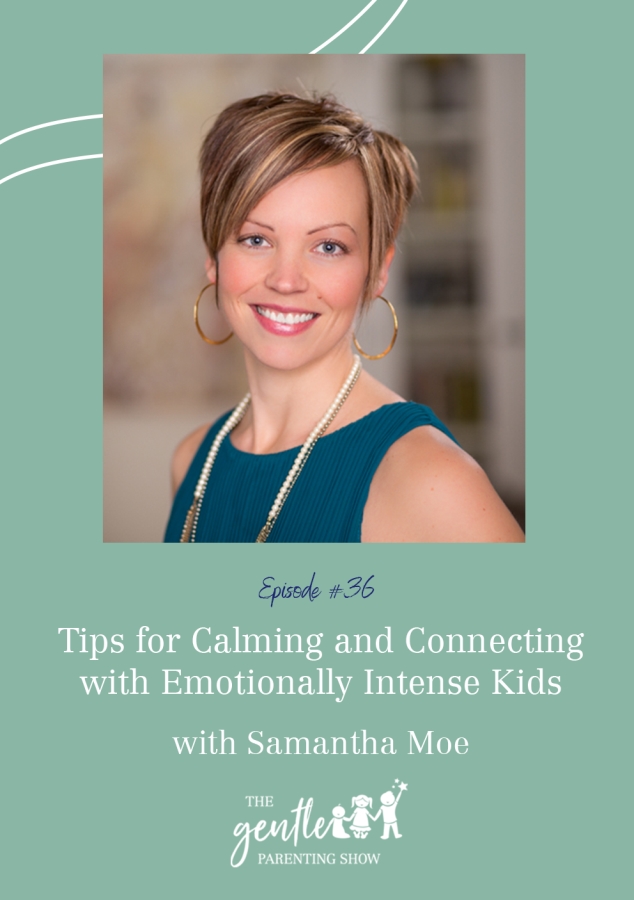On today’s episode of The Gentle Parenting Show, Kim sits with Samantha Moe. Samantha is a certified parent coach and speaker and has coached parents on how to help their children calm, connect and cooperate. She provides continuing education, advanced training, and parent coach certification for family service professionals who support intense kids and their families. Samantha is the creator of the Mad to Glad BlueprintTM, a revolutionary brain-and-nervous-system-based approach to positive communication and parenting that works to soothe and even preempt intense kids’ most challenging behaviors. Today, Samantha and Kim discuss working with an emotionally intense child.
What Does Emotionally Intense Mean?
Before Samantha breaks down how to help emotionally intense kids, she explains what that means. Every child has a different temperament, and sometimes parents can recognize this from birth. She said that every child has gifts, and she used her 6 years of education and training to find out how to identify the gifts of emotionally intense children.
Through her research, Samantha found that “in order to help a child connect and relate, their brain needs to feel calm and needs to feel safe.” It became her mission and calling to figure out relationship strategies for an emotionally intense child so they can feel safe and connected.
Mirror Neurons and Emotions
Kim points out in the discussion that for children, and even small babies, to feel calm and safe, they need their parents to be in a calm, centered place. There is brain science behind this. We have mirror neurons in our brains. For a child, when a parent loses their cool, the child will mirror that behavior and new neuro-pathways will be created.
Samantha points out that underneath intense behavior, the fight or flight hormone is fired up. Even if all you asked was your child to sleep, if you do it in an intense or angry way, your child may respond in a fearful way. Samantha calls this fight or flight mode “fire in the brain”.
Where to Start With Emotionally Intense Children
The first step, according to Samantha, is to put the fire in the brain out. In the intense moments, you may think that if you have better discipline, it will make your child listen. But, Samantha quotes Dr. Segal and his findings on the upstairs and downstairs brain. When your child is in fight or flight mode (which occurs in the downstairs brain), a child can’t have their upstairs brain functioning.
The upstairs brain is impacted by emotion. There are three things that we may think are good for dealing with our children in this state, but Samantha breaks them down.
- Problem Solving: When our child’s downstairs brain is firing, it’s not great to try and problem-solve with your child. It won’t be effective.
- Attention Strategies: Asking your child to look at you or follow your eyes won’t be effective when your child has fire in the brain.
- Breathing Strategies: Breathing can be an effective strategy, but when you try to do that with a child with fire in the brain, it won’t happen.
Modeling Calmness for Our Children
When your child has fire in the brain, we can model grounded and safe behaviors. Remember, our brains are fully developed, and our children’s brains are not. Samantha said to model safe behavior, her mantra is “calm body, calm voice, calm face.” By modeling calmness, we are firing those mirror neurons.
But, how do we stay calm in a modern world? Samantha shares a great analogy that we are in a “so that” society. We do everything “so that” we can accomplish something else. To model calmness as parents, we need to find enough practice during the day to calm the fire, or else every little thing can be triggering.
The Three C’s for Emotionally Intense Children
Samantha shares her three C’s for helping an emotionally intense child: calm, connection, and collaboration.
These three C’s work in sequential order and as teammates. If you help a child connect to their emotions, meaning you’re with them in an emotional state, you’re labeling the emotion which creates ease in their body. After that ease, the connection can come.
To get to calm, we need to slow down and create some simplicity and space in our day. So often we just want to fix things fast for our children, but they need the time and space to calm down. After you get them to calm and name their emotions, you can collaborate and what to do about it. Ask them questions about how they were feeling, and how as parents we can help them when they get in emotionally intense states.
Once you have an action plan with your kids, they can trust you and you can work on it together, in a collaborative way.
More Help From Samantha
Samantha offers classes and resources for parents and professionals. Her flagship course, Mad to Glad, is an 8-week course for parents. Each week, parents are given a challenge to help them find out what’s happening beneath behaviors. You can purchase the course, access free resources, and even sign up for 1:1 coaching on her website.
For her last bit of wisdom, Samantha shares a Japanese proverb. “What was the best time to plant a tree? 20 years ago. When is the next best time? Today.” She says it’s never too late to seek out help for you and your child. It’s never too late to start.
Follow Samantha
- Samantha’s WEBSITE





